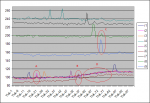rolfi@tisco.no
Member
The following is from manual 2 (7.9.1 10/2013) p. 248 about the touch16 command:
IMPORTANT - Never ‘directly touch’ a touch sensor (e.g. a piece of bare wire)!
A touch sensor must be electrically isolated from the end user.
I guess that is to prevent damage by electrostatic discharge. However, a series resistor for electrostatic protection between finger and c.4 on a 8M2 works quite well up to several megaohms.
I find this method very tempting, and would appreciate opinions from the forum on possible chip damage.
Thanks!
IMPORTANT - Never ‘directly touch’ a touch sensor (e.g. a piece of bare wire)!
A touch sensor must be electrically isolated from the end user.
I guess that is to prevent damage by electrostatic discharge. However, a series resistor for electrostatic protection between finger and c.4 on a 8M2 works quite well up to several megaohms.
I find this method very tempting, and would appreciate opinions from the forum on possible chip damage.
Thanks!

